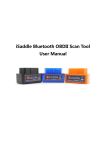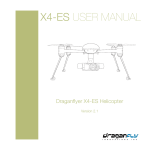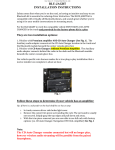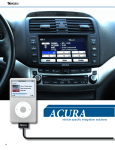Download A guide to using your hire van
Transcript
A users guide to the Large hire van. So, you have booked a hire van with us!, we hope that your rental trip goes without issue. This is a quick guide covering our most popular hire van, the Ford Transit. The Ford Transit makes an ideal rental van, it is economical, reliable and simple to operate. This guide will cover some of the features of the vehicle and some common issues that people come across while using these vans. Keys, doors and locking mechanism. The most frequent calls we get in relation to these hire vans is the operation of the locking system. The standard Ford remote contains a rechargeable battery which to be honest is not very reliable. The remote has three buttons. • The padlock button locks all doors of the van. • The open padlock unlocks the drivers and passenger doors. • The boot button opens the rear and side doors. • A common issue with the current generation transit is the auto locking system. When the van exceeds 10mph it locks the rear and side doors. So when your eager passenger jumps out and starts tugging at the handle and wondering why the door will not open, it needs to be opened with the remote. What do I do if the remote fails? - sometimes remotes fail to charge, if this is the case its simple to open the rear and side doors. Put the key into the driver side door lock of the hire van. Turn the key quickly twice to the right, the rear and side doors will be unlocked. Under the Bonnet: Common Checks Illustration 1: Two quick flicks to the right will open the rear doors in your hire van. If If you have a hire van for an extended length of time, it makes sense to check these items. • The tyres of a hire vehicle will have the recommended pressure printed on the side-wall of the tyre. These are quoted in PSI, an air pump will have a gauge on it to show you when the correct pressure has been reached. Keeping the correct pressure in the tyre is important for ride comfort and braking performance. • The coolant levels and oil levels can be checked from the engine bay. To access the engine bay on the rental van it is necessary to use the key. There is keyhole just beneath the front edge of the bonnet. Turn the key to the left and then to the right, the bonnet should make an audible click to let you know it has been released. The washer bottle filler is also in the engine bay, this has a blue cap. • Fuel and filling. The fuel tank is located on the passenger side back from the cab door. There is a flap which simply pulls open. The cap can be opened with the ignition key. Transits use diesel. If you accidentally put petrol into your van, stop!! Driving a diesel vehicle which has petrol in the tank can irreparably damage the engine. Call us and we will assist you. Driving the transit and safety tips. A transit hire van is not a difficult vehicle to drive, however certain steps should be taken. Adjust the mirrors of the vehicle before you drive off. This is critical as there is no rear view mirror. Mirrors should be adjust so you can see the sides of the van clearly and also vehicles to your left and right. 1. The transit is longer than your car, hence the most common reason for damage is catching the side of the van off walls, pillars, neighbours cars ect. To minimise the risk of this, it is essential that you can see the side of the vehicle clearly from the cabin. Other important notes The Standard hire transit is 5.6 metres in length and 2.4 metres high, so take car in car parks and with booking ferries. 2. Use your passenger. If you have a travelling partner they are an extra set of eyes. They can guide you in and out of tight spots and indicate when traffic from their side is clear. Believe us when we say, a good passenger could stop 80% of damage to vehicles occurring. 3. Engine management lights are quite common, if a yellow light comes on please ring us, if a red light comes on , please stop the vehicle and call us. 4. Do not admit liability, If you are involved in an accident, call the police if needed and contact us. We have experience in dealing with situations like this and will help you. Punctures and tyre issues. We always check the condition of tyres prior to a rental. However, this does not stop punctures happening. A puncture is an inconvenience to the hire customer but hardly a disaster. The tools for dealing with it a under your feet - literally!. There is a flap which contains • • • A jack A wheel brace A winding bar. The spare wheel is located under the rear doors. When you open the rear doors there is a bolt which needs to be removed with the wheel brace. Then use the wheel brace to wind down the spare wheel via the hole that the removed bolt was blocking. Its all in the user manual which is in the glovebox. When you have the wheel changed place the punctured wheel in the back of the van and tell us upon return. This eliminates the risk of a later customer going out with a flat spare tyre. One final note on tyres, pay attention to the passenger side tyres in particular. These commonly get damaged by kerbs, so use your wing mirrors, especially when reversing into parking spots etc.








